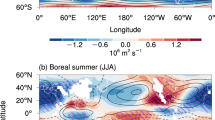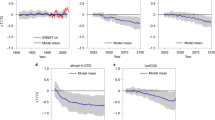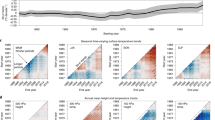Abstract
The North American continent generally experienced a cooling trend in winter over the early 2000s. This cooling trend represented a significant deviation from expected anthropogenic warming and so requires explanation. Previous studies indicate that climate variations in the tropical Pacific contributed to many mid-latitude climate variations over the early twenty-first century. Here we show using large ensembles of fully coupled, partially coupled and uncoupled model simulations that in northwest North America the winter cooling was primarily a remote response to climate fluctuations in the tropical Pacific. By contrast, in central North America the winter cooling appears to have resulted from a relatively rare fluctuation in mid-latitude circulation that was unrelated to the tropical Pacific. Our results highlight how decadal climate signals—both remote and local in origin—can together offset anthropogenic warming to produce continental-scale cooling.
This is a preview of subscription content, access via your institution
Access options
Subscribe to this journal
Receive 12 print issues and online access
$209.00 per year
only $17.42 per issue
Buy this article
- Purchase on Springer Link
- Instant access to full article PDF
Prices may be subject to local taxes which are calculated during checkout






Similar content being viewed by others
References
Cohen, J. L., Furtado, J. C., Barlow, M., Alexeev, V. A. & Cherry, J. E. Asymmetric seasonal temperature trends. Geophys. Res. Lett. 39, L04705 (2012).
Hartmann, D. L. Pacific sea surface temperature and the winter of 2014. Geophys. Res. Lett. 42, 1894–1902 (2015).
Palmer, T. Record-breaking winters and global climate change. Science 344, 803–804 (2014).
Yu, B. & Zhang, X. A physical analysis of the severe 2013/2014 cold winter in North America. J. Geophys. Res. 120, 149–165 (2015).
England, M. et al. Recent intensification of wind-driven circulation in the Pacific and the ongoing warming hiatus. Nature Clim. Change 4, 222–227 (2014).
Fyfe, J. C. et al. Making sense of the early-2000s warming slowdown. Nature Clim. Change 6, 224–228 (2016).
Ding, Q. et al. Tropical forcing of the recent rapid Arctic warming in northeastern Canada and Greenland. Nature 509, 209–212 (2014).
Delworth, T. L., Zeng, F., Rosati, A., Vecchi, G. A. & Wittenberg, A. T. A link between the hiatus in global warming and North American drought. J. Clim. 28, 3834–3845 (2015).
Trenberth, K. E., Fasullo, J. T., Branstator, G. & Phillips, A. S. Seasonal aspects of the recent pause in surface warming. Nature Clim. Change 4, 911–916 (2014).
Kosaka, Y. & Xie, S.-P. Recent global-warming hiatus tied to equatorial Pacific surface cooling. Nature 501, 403–407 (2013).
Alexander, M. A. et al. The atmospheric bridge: the influence of ENSO teleconnections on air–sea interaction over the global oceans. J. Clim. 15, 2205–2231 (2002).
Seager, R. et al. Causes and Predictability of the 2011–14 California Drought NOAA Drought Task Force Assessment Report (NOAA, 2015); http://cpo.noaa.gov/ClimatePrograms/ModelingAnalysisPredictionsandProjections/MAPPTaskForces/DroughtTaskForce1/CaliforniaDrought.aspx
Arora, V. K. et al. Carbon emission limits required to satisfy future representative concentration pathways of greenhouse gases. Geophys. Res. Lett. 38, 3–8 (2011).
Hurrell, J. W. et al. The community earth system model: a framework for collaborative research. Bull. Am. Meteorol. Soc. 94, 1339–1360 (2013).
Meinshausen, M. et al. The RCP greenhouse gas concentrations and their extensions from 1765 to 2300. Climatic Change 109, 213–241 (2011).
Saenko, O. A., Fyfe, J. C., Swart, N. C., Lee, W. G. & England, M. H. Influence of tropical wind on global temperature from months to decades. Clim. Dynam. http://dx.doi.org/10.1007/s00382-015-2958-6 (in the press).
Palmer, T. & Mansfield, D. Response of two atmospheric general circulation models to sea-surface temperature anomalies in the tropical east and west Pacific. Nature 310, 483–485 (1984).
Simmons, A., Wallace, J. M. & Branstator, G. Barotropic wave propagation and instability, and atmospheric teleconnection patterns. J. Atmos. Sci. 40, 1363–1392 (1983).
Hansen, J., Ruedy, R., Sato, M. & Lo, K. Global surface temperature change. Rev. Geophys. 48, RG4004 (2010).
Dee, D. P. et al. The ERA-interim reanalysis: configuration and performance of the data assimilation system. Q. J. R. Meteorol. Soc. 137, 553–597 (2011).
Adler, R. F. et al. The version-2 global precipitation climatology project (GPCP) monthly precipitation analysis (1979–present). J. Hydrometeorol. 4, 1147–1167 (2003).
de Boisséson, E., Balmaseda, M. A., Abdalla, S., Källén, E. & Janssen, P. A. E. M. How robust is the recent strengthening of the Tropical Pacific trade winds? Geophys. Res. Lett. 41, 4398–4405 (2014).
Compo, G. P. et al. The twentieth century reanalysis project. Q. J. R. Meteorol. Soc. 137, 1–28 (2011).
Kay, J. E. et al. The Community Earth System Model (CESM) large ensemble project: a community resource for studying climate change in the presence of internal climate variability. Bull. Am. Meteorol. Soc. 96, 1333–1349 (2015).
von Salzen, K. et al. The Canadian Fourth Generation Atmospheric Global Climate Model (CanAM4). Part I: representation of physical processes. Atmos.-Ocean 51, 104–125 (2013).
Rayner, N. A. Global analyses of sea surface temperature, sea ice, and night marine air temperature since the late nineteenth century. J. Geophys. Res. 108, 4407 (2003).
Acknowledgements
We thank O. Saenko and W. Lee for helping design and perform the pacemaker simulations, J. Scinocca for helping extend the CanESM2 large ensemble, Y. Jiao for technical assistance, N. Gillett, B. Merryfield and N. Swart for their comments on an earlier draft, C. Fletcher for helpful discussions and the CESM group for providing the CESM large ensemble model output.
Author information
Authors and Affiliations
Contributions
M.S. designed and performed the uncoupled simulations, helped to carry out the analysis and wrote the initial draft. J.C.F. helped design the pacemaker experiments, helped with the analysis and edited the manuscript.
Corresponding author
Ethics declarations
Competing interests
The authors declare no competing financial interests.
Supplementary information
Supplementary Information
Supplementary Information (PDF 1368 kb)
Rights and permissions
About this article
Cite this article
Sigmond, M., Fyfe, J. Tropical Pacific impacts on cooling North American winters. Nature Clim Change 6, 970–974 (2016). https://doi.org/10.1038/nclimate3069
Received:
Accepted:
Published:
Issue Date:
DOI: https://doi.org/10.1038/nclimate3069
This article is cited by
-
Strengthened impact of boreal winter North Pacific Oscillation on ENSO development in warming climate
npj Climate and Atmospheric Science (2024)
-
Nonstationary modulation of the preceding spring North Pacific Victoria mode on the connection of central North America winter temperature with ENSO
Climate Dynamics (2024)
-
The warm Arctic-cold north american pattern in CanESM5 large ensemble simulations: Eurasian influence and uncertainty due to internal variability
Climate Dynamics (2024)
-
Multidecadal seesaw in cold wave frequency between central Eurasia and Greenland and its relation to the Atlantic Multidecadal Oscillation
Climate Dynamics (2022)
-
Impacts of large-scale oscillations on climate variability over North America
Climatic Change (2022)



